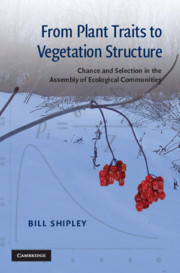 From Plant Traits to Vegetation Structure
From Plant Traits to Vegetation Structure Book contents
- Frontmatter
- Contents
- Preface
- 1 Playing with loaded dice
- 2 Population-based models of community assembly
- 3 Trait-based community ecology
- 4 Modeling trait-based environmental filters: Bayesian statistics, information theory and the Maximum Entropy Formalism
- 5 Community dynamics, natural selection and the origin of community-aggregated traits
- 6 Community assembly during a Mediterranean succession
- 7 The statistical mechanics of species abundance distributions
- 8 Epilogue: traits are not enough
- References
- Index
8 - Epilogue: traits are not enough
Published online by Cambridge University Press: 05 June 2012
- Frontmatter
- Contents
- Preface
- 1 Playing with loaded dice
- 2 Population-based models of community assembly
- 3 Trait-based community ecology
- 4 Modeling trait-based environmental filters: Bayesian statistics, information theory and the Maximum Entropy Formalism
- 5 Community dynamics, natural selection and the origin of community-aggregated traits
- 6 Community assembly during a Mediterranean succession
- 7 The statistical mechanics of species abundance distributions
- 8 Epilogue: traits are not enough
- References
- Index
Summary
Throughout this book I have contrasted “neutral” processes with “selective” processes that are based on trait-based environmental filtering. If “neutral” is interpreted in its strict sense of requiring exactly equivalent fitness between all individuals of all species then community assembly is either neutral or it is not. As I have already argued, such a strict conception of neutral community assembly makes no sense, except as a benchmark to measure departures, because it makes natural selection impossible. If “neutral” is interpreted more loosely, as any process that is independent of functional trait differences and that affects population dynamics by affecting realized rates of survival, reproduction or immigration, then community assembly almost surely occurs through an interplay of both “neutral” and “selective” processes. This looser meaning of “neutral” would include the stochastic demographic effects of birth, death and immigration that are especially important when population sizes are small but would also include all those dispersal limitations, including landscape features and history, which prevent propagules from moving between local communities and which are not related to functional traits. In what follows I will use “neutral” in this less rigid sense. In real ecological communities traits are not enough because such neutral processes always exist. Some communities might be predominantly structured by neutral processes while others might be predominantly structured by selective processes. The relative importance of these two groups of processes will determine whether or not the model developed in this book will have good predictive ability or not.
- Type
- Chapter
- Information
- From Plant Traits to Vegetation StructureChance and Selection in the Assembly of Ecological Communities, pp. 255 - 259Publisher: Cambridge University PressPrint publication year: 2009


